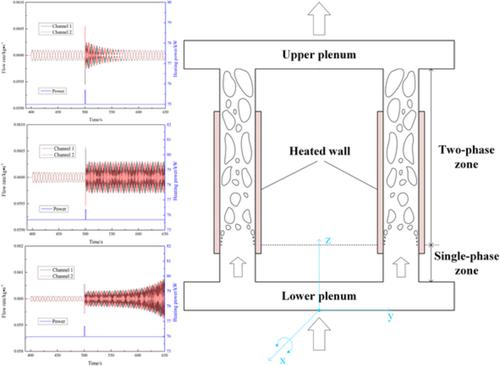当前位置:
X-MOL 学术
›
Int. J. Energy Res.
›
论文详情
Our official English website, www.x-mol.net, welcomes your
feedback! (Note: you will need to create a separate account there.)
Research of two‐phase density wave instability in reactor core channels with rolling motion
International Journal of Energy Research ( IF 4.3 ) Pub Date : 2020-04-29 , DOI: 10.1002/er.5444 Wenxi Tian 1 , Qiang Lian 1 , Suizheng Qiu 1 , G.H. Su 1
International Journal of Energy Research ( IF 4.3 ) Pub Date : 2020-04-29 , DOI: 10.1002/er.5444 Wenxi Tian 1 , Qiang Lian 1 , Suizheng Qiu 1 , G.H. Su 1
Affiliation

|
In this study, two‐phase density wave instability in parallel‐twin rectangular channels was investigated with axially nonuniform heat profiles in the reactor core combined with static and rolling conditions. A parallel‐channel thermal‐hydraulic model was built using the method of two‐phase homogeneous flow developed in previous work, while the drift‐flux approach for void fraction and profile‐fit model for subcooled boiling were implemented. Although the rolling condition was chosen as the typical motion in this work, the additional force caused by the motion with six degrees of freedom was derived. The theoretical analysis was performed based on the method of small power perturbation for parallel‐twin rectangular channels. The flow oscillation caused by rolling was studied for different system parameters, including inlet resistance, exit resistance, pressure, and axial heating profile. The influence on flow instability of rolling parameters such as period, amplitude, and distance between channels was analyzed. The results showed that it would destabilize the system if a larger additional force was generated by rolling parameters. The influence of different axial heat profiles on flow instability was also studied under inlet‐peaked, cosine‐shape, and outlet‐peaked heat fluxes. The coupling effect of rolling motion and axial nonuniform heating was finally studied. The stability boundaries under different conditions were compared to the inherent boundary under the static condition with uniform heating. The results indicated that the influence of nonuniform heating was more evident and should be paid more attention to.
中文翻译:

滚动运动反应堆堆芯通道内两相密度波不稳定性的研究
在这项研究中,研究了平行双矩形通道中的两相密度波不稳定性,并结合了静态和滚动条件对反应堆堆芯的轴向非均匀热分布进行了研究。使用先前工作中开发的两相均相流方法建立了平行通道热工水力模型,同时采用了空隙率的漂移通量方法和过冷沸腾的轮廓拟合模型。尽管在此工作中选择了滚动条件作为典型运动,但仍得出了由具有六个自由度的运动引起的附加力。理论分析是基于小功率扰动对平行双矩形通道的方法进行的。针对不同的系统参数(包括入口阻力,出口阻力,压力和轴向加热曲线。分析了诸如周期,振幅和通道之间距离之类的滚动参数对流动不稳定性的影响。结果表明,如果滚动参数产生更大的附加力,它将破坏系统的稳定性。在入口峰值,余弦形状和出口峰值热通量下,还研究了不同轴向热曲线对流动不稳定性的影响。最后研究了滚动运动与轴向不均匀加热的耦合作用。将均匀加热条件下不同条件下的稳定性边界与静态条件下的固有边界进行比较。结果表明,加热不均匀的影响更为明显,应引起重视。分析了诸如周期,振幅和通道之间距离之类的滚动参数对流动不稳定性的影响。结果表明,如果滚动参数产生更大的附加力,它将破坏系统的稳定性。在入口峰值,余弦形状和出口峰值热通量下,还研究了不同轴向热曲线对流动不稳定性的影响。最后研究了滚动运动与轴向不均匀加热的耦合作用。将均匀加热条件下不同条件下的稳定性边界与静态条件下的固有边界进行比较。结果表明,加热不均匀的影响更为明显,应引起重视。分析了诸如周期,振幅和通道之间距离之类的滚动参数对流动不稳定性的影响。结果表明,如果滚动参数产生更大的附加力,它将破坏系统的稳定性。在入口峰值,余弦形状和出口峰值热通量下,还研究了不同轴向热剖面对流动不稳定性的影响。最后研究了滚动运动与轴向不均匀加热的耦合作用。将均匀加热条件下不同条件下的稳定性边界与静态条件下的固有边界进行比较。结果表明,加热不均匀的影响更为明显,应引起重视。结果表明,如果滚动参数产生更大的附加力,它将破坏系统的稳定性。在入口峰值,余弦形状和出口峰值热通量下,还研究了不同轴向热剖面对流动不稳定性的影响。最后研究了滚动运动与轴向不均匀加热的耦合作用。将均匀加热条件下不同条件下的稳定性边界与静态条件下的固有边界进行比较。结果表明,加热不均匀的影响更为明显,应引起重视。结果表明,如果滚动参数产生更大的附加力,它将破坏系统的稳定性。在入口峰值,余弦形状和出口峰值热通量下,还研究了不同轴向热剖面对流动不稳定性的影响。最后研究了滚动运动与轴向不均匀加热的耦合作用。将均匀加热条件下不同条件下的稳定性边界与静态条件下的固有边界进行比较。结果表明,加热不均匀的影响更为明显,应引起重视。和出口峰值热通量。最后研究了滚动运动与轴向不均匀加热的耦合作用。将均匀加热条件下不同条件下的稳定性边界与静态条件下的固有边界进行比较。结果表明,加热不均匀的影响更为明显,应引起重视。和出口峰值热通量。最后研究了滚动运动与轴向不均匀加热的耦合作用。将均匀加热条件下不同条件下的稳定性边界与静态条件下的固有边界进行比较。结果表明,加热不均匀的影响更为明显,应引起重视。
更新日期:2020-04-29
中文翻译:

滚动运动反应堆堆芯通道内两相密度波不稳定性的研究
在这项研究中,研究了平行双矩形通道中的两相密度波不稳定性,并结合了静态和滚动条件对反应堆堆芯的轴向非均匀热分布进行了研究。使用先前工作中开发的两相均相流方法建立了平行通道热工水力模型,同时采用了空隙率的漂移通量方法和过冷沸腾的轮廓拟合模型。尽管在此工作中选择了滚动条件作为典型运动,但仍得出了由具有六个自由度的运动引起的附加力。理论分析是基于小功率扰动对平行双矩形通道的方法进行的。针对不同的系统参数(包括入口阻力,出口阻力,压力和轴向加热曲线。分析了诸如周期,振幅和通道之间距离之类的滚动参数对流动不稳定性的影响。结果表明,如果滚动参数产生更大的附加力,它将破坏系统的稳定性。在入口峰值,余弦形状和出口峰值热通量下,还研究了不同轴向热曲线对流动不稳定性的影响。最后研究了滚动运动与轴向不均匀加热的耦合作用。将均匀加热条件下不同条件下的稳定性边界与静态条件下的固有边界进行比较。结果表明,加热不均匀的影响更为明显,应引起重视。分析了诸如周期,振幅和通道之间距离之类的滚动参数对流动不稳定性的影响。结果表明,如果滚动参数产生更大的附加力,它将破坏系统的稳定性。在入口峰值,余弦形状和出口峰值热通量下,还研究了不同轴向热曲线对流动不稳定性的影响。最后研究了滚动运动与轴向不均匀加热的耦合作用。将均匀加热条件下不同条件下的稳定性边界与静态条件下的固有边界进行比较。结果表明,加热不均匀的影响更为明显,应引起重视。分析了诸如周期,振幅和通道之间距离之类的滚动参数对流动不稳定性的影响。结果表明,如果滚动参数产生更大的附加力,它将破坏系统的稳定性。在入口峰值,余弦形状和出口峰值热通量下,还研究了不同轴向热剖面对流动不稳定性的影响。最后研究了滚动运动与轴向不均匀加热的耦合作用。将均匀加热条件下不同条件下的稳定性边界与静态条件下的固有边界进行比较。结果表明,加热不均匀的影响更为明显,应引起重视。结果表明,如果滚动参数产生更大的附加力,它将破坏系统的稳定性。在入口峰值,余弦形状和出口峰值热通量下,还研究了不同轴向热剖面对流动不稳定性的影响。最后研究了滚动运动与轴向不均匀加热的耦合作用。将均匀加热条件下不同条件下的稳定性边界与静态条件下的固有边界进行比较。结果表明,加热不均匀的影响更为明显,应引起重视。结果表明,如果滚动参数产生更大的附加力,它将破坏系统的稳定性。在入口峰值,余弦形状和出口峰值热通量下,还研究了不同轴向热剖面对流动不稳定性的影响。最后研究了滚动运动与轴向不均匀加热的耦合作用。将均匀加热条件下不同条件下的稳定性边界与静态条件下的固有边界进行比较。结果表明,加热不均匀的影响更为明显,应引起重视。和出口峰值热通量。最后研究了滚动运动与轴向不均匀加热的耦合作用。将均匀加热条件下不同条件下的稳定性边界与静态条件下的固有边界进行比较。结果表明,加热不均匀的影响更为明显,应引起重视。和出口峰值热通量。最后研究了滚动运动与轴向不均匀加热的耦合作用。将均匀加热条件下不同条件下的稳定性边界与静态条件下的固有边界进行比较。结果表明,加热不均匀的影响更为明显,应引起重视。











































 京公网安备 11010802027423号
京公网安备 11010802027423号